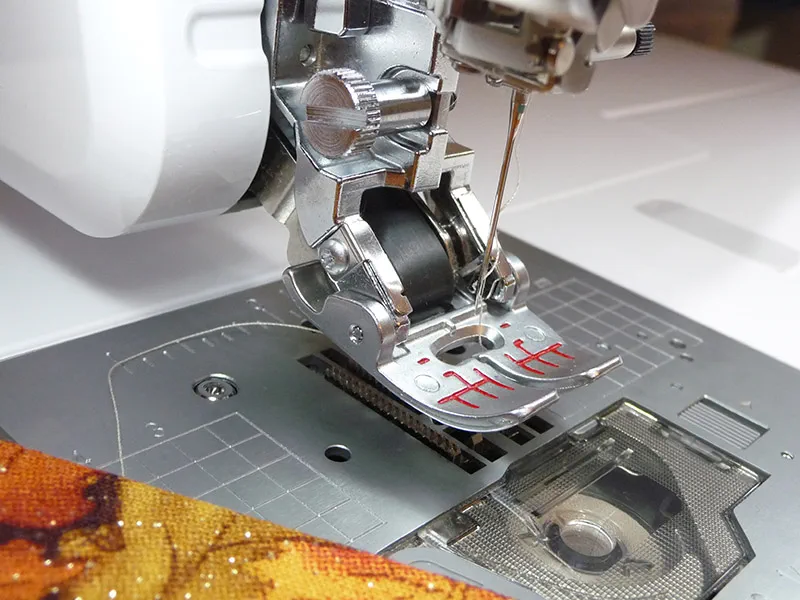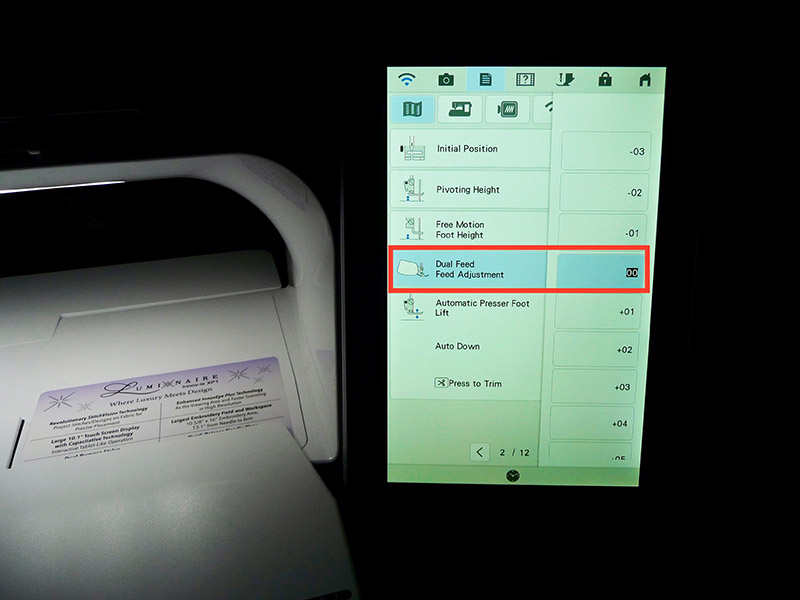Quick Tip: Getting to know the MuVit Dual Feed Foot Part One
 The Brother MuVit foot is a unique specialty foot designed to enhance the feeding of fabric layers. Note that this foot is included with specific Brother machines and available as an option for others. Visit Brother-usa.com
The Brother MuVit foot is a unique specialty foot designed to enhance the feeding of fabric layers. Note that this foot is included with specific Brother machines and available as an option for others. Visit Brother-usa.comto learn more and contact your local Brother dealer
to explore your options. To understand how this foot is different, it’s helpful to know how machines are designed to work under ordinary sewing circumstances. With standard presser feet, the presser foot puts pressure on fabric under the foot, keeping it in place while the stitch forms, and then the feed dogs advance the fabric and carry fabric layers in a forward, backward, or possibly even a side to side motion. If you’ve ever tried to do “normal” sewing with the feed dogs unintentionally in the down position you know that the fabric simply stays in place without the benefit of the feed dogs to move what’s underneath the presser foot. When sewing with standard sewing feet there may be a slight amount of easing of the fabric that comes in contact with the bottom, feed dog side. Since the top layer of fabric is not in direct contact with the feed dogs the two layers may shift or feed at a different rate. As part of the sewing operation we compensate for this in many different ways. We may use pins to secure fabric layers, use hand basting to keep material layers together, or we may use conscious, or even unconscious methods of holding the fabric so that both our top and bottom layers move evenly through the machine. These common methods can work in many situations. However, in other, more challenging situations, we find that fabric layers tend to misbehave and fight with one another, especially when we’re combining fabric layers that are unalike and feed differently. That’s where an even feed foot comes to the rescue! You may already be familiar with a Walking Foot. This foot is available for Brother machines with zig zag capability and is found in a 7mm version
and a 5mm version.
I’ll talk more about the Walking foot in the near future. This tip sheet highlights the MuVit foot. You can think of it as a close cousin to the walking foot, but it really is quite unique. This foot is a digitally controlled, motor driven even feed foot designed for powerful, precision sewing on a wide range of fabrics and fabric combinations. You may think of it as a walking foot with superpowers! Let’s explore some unique characteristics of the MuVit foot. Notice the plug at the back of the foot.
 This is inserted in a specific spot at the back of the machine and it tells the machine the foot is operable.
This is inserted in a specific spot at the back of the machine and it tells the machine the foot is operable.
 When selecting stitches on the screen of the machine you’ll see that some are greyed out, and unsuitable for sewing with this foot. This is a great help since there is no chance of making a mistake and choosing the wrong stitch for use with MuVit foot feeding action.
To attach the foot to the machine, the standard foot holder is removed and the foot is securely screwed in place.
When selecting stitches on the screen of the machine you’ll see that some are greyed out, and unsuitable for sewing with this foot. This is a great help since there is no chance of making a mistake and choosing the wrong stitch for use with MuVit foot feeding action.
To attach the foot to the machine, the standard foot holder is removed and the foot is securely screwed in place.
 The MuVit foot comes with a standard closed toe sole plate with distinct markings useful for pivoting and alignment on a variety of different projects. Markings are especially useful for specific seam allowances and accurate stitching on quilt blocks when you want stitches evenly spaced a distance from existing seams and finished edges. Notice the black belt in the center. The built-in motor on the foot drives this belt as it makes contact with the fabric layers and feeds the fabric with dual action, working along with the feed dogs and controlling the movement on both top and bottom layers as you stitch.
The MuVit foot comes with a standard closed toe sole plate with distinct markings useful for pivoting and alignment on a variety of different projects. Markings are especially useful for specific seam allowances and accurate stitching on quilt blocks when you want stitches evenly spaced a distance from existing seams and finished edges. Notice the black belt in the center. The built-in motor on the foot drives this belt as it makes contact with the fabric layers and feeds the fabric with dual action, working along with the feed dogs and controlling the movement on both top and bottom layers as you stitch.
 The lever on the foot needs to be in the down position for the foot to work its magic. However, the lever can be flipped to the up position to deactivate the dual feed action and sew without having the dual feed action take place.
The lever on the foot needs to be in the down position for the foot to work its magic. However, the lever can be flipped to the up position to deactivate the dual feed action and sew without having the dual feed action take place.
 The standard/default setting for the foot is 00. By accessing the set mode on the machine you’ll see that there is a wide span of settings ranging from positive 10 to negative 10. There is no hard and fast formula for which settings to choose but it’s helpful to know that increases in the positive range means the belt will move faster and consequently in the negative range the belt will move slower. The wide range of settings allows for incremental adjustments. Experimentation and experience are your best guide for using customized settings. Simply put, if your top layer(s) need more easing, you’ll want to increase the positive setting, thus speeding up the drive of the belt. If your top layer(s) needs to be stretched out to provide more taught sewing, you’ll want to go towards the negative setting, so the belt moves slower.
The standard/default setting for the foot is 00. By accessing the set mode on the machine you’ll see that there is a wide span of settings ranging from positive 10 to negative 10. There is no hard and fast formula for which settings to choose but it’s helpful to know that increases in the positive range means the belt will move faster and consequently in the negative range the belt will move slower. The wide range of settings allows for incremental adjustments. Experimentation and experience are your best guide for using customized settings. Simply put, if your top layer(s) need more easing, you’ll want to increase the positive setting, thus speeding up the drive of the belt. If your top layer(s) needs to be stretched out to provide more taught sewing, you’ll want to go towards the negative setting, so the belt moves slower.
 Keep a record of various settings with fabric combinations you plan to repeat, and you’ll be on your way to completing your project sooner the next time around. Tricky fabrics and fabric combinations are easily overcome using the power of this digitally controlled super feeding foot! I hope these tips help you get acquainted with the Brother MuVit foot. Stay tuned for the next installment. In the meantime, we welcome your comments and questions!
Keep a record of various settings with fabric combinations you plan to repeat, and you’ll be on your way to completing your project sooner the next time around. Tricky fabrics and fabric combinations are easily overcome using the power of this digitally controlled super feeding foot! I hope these tips help you get acquainted with the Brother MuVit foot. Stay tuned for the next installment. In the meantime, we welcome your comments and questions!

